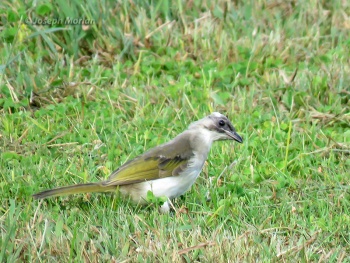Alternative name: Chinese Bulbul
- Pycnonotus sinensis
Identification
18-19 cm (7-7½ in)
- Black crown
- Black moustachial stripe
- Broad white postocular stripes extending across nape.
- White spot on ear coverts
- Gray mantle and rump
- Olive-green wing coverts and tail.
- Underparts whitish with broad gray or brownish chest band
- Eye, bill and feet dark.
Juvenile similar to adult, but head and underparts uniform gray. Immature like adult but head and breast pattern paler and more blended.
Distribution
Asia: found in China, Taiwan, Hong Kong, southern Japan
Southeast Asia: Indochina, Laos, Vietnam
Taxonomy
Subspecies
There are 4 subspecies[1]:
- P. s. sinensis:
- Central and eastern China (Sichuan and southern Shaanxi) east to Jiangsu, and south to Guangxi, Guangdong and Fujian; also isolated sites in Beijing and Hebei); partially migratory, some moving in winter to central Vietnam, Hainan, and South Korea
- P. s. hainanus:
- South China (south-western Guangdong and southern Guangxi); northern Vietnam; Hainan
- P. s. formosae:
- P. s. orii:
- South Ryukyu Islands (Yonaguni and Ishigaki)
Previously recognized P. s. hoyi from Middle Yangtze River Valley (Sichuan, Hubei and Hunan) was described from a juvenile specimen and is a junior synonym of nominate.
Habitat
Open woodland, srub, cultivated areas, orchards, gardens with large shrubs.
Behaviour
Diet
Their diet consists of a variety of berries, figs, fruit and vegetables, with the addition of insects such as dipteran flies.
Breeding
Nest is a firm cup made of broad grasses and lined with finer grass and rootlets. Other materials sometimes incorporated. Clutch of 3-4 eggs, rarely five.
Vocalisations
Song is a strident whistled warble often repeated. Calls rather nasal, sometimes subdued.
Movements
Largely resident but northern populations migratory.
References
- Clements, J. F., T. S. Schulenberg, M. J. Iliff, S. M. Billerman, T. A. Fredericks, B. L. Sullivan, and C. L. Wood. 2019. The eBird/Clements Checklist of Birds of the World: v2019. Downloaded from http://www.birds.cornell.edu/clementschecklist/download/
- Avibase
- Fishpool, L. & Tobias, J. (2019). Light-vented Bulbul (Pycnonotus sinensis). In: del Hoyo, J., Elliott, A., Sargatal, J., Christie, D.A. & de Juana, E. (eds.). Handbook of the Birds of the World Alive. Lynx Edicions, Barcelona. (retrieved from https://www.hbw.com/node/57937 on 5 October 2019).
- Brazil, M. (2018). Birds of Japan. Helm, London. ISBN 978-1-4729-1386-9
- Brazil, M. (1991). The Birds of Japan. Smithsonian Inst. Press. Washington, D.C. ISBN 1-56098-030-3
- Takeshi Y. (2002) Seasonal variation of plumage color in Japanese Lightvented Bulbul Pycnonotus sinensis orii in the Yaeyama Group, Southern Ryukyus. Ornithol. Sci. 1: 155–158
- Takeshi Y. (2006) Taxonomic status of populations of the light-vented Bulbul Pycnonotus sinensis (Gmelin, 1789) (Passeriformes: Pycnonotidae) in Taiwan and the southern Ryukyus. Zoological Studies 45 (2): 168-179.
Recommended Citation
- BirdForum Opus contributors. (2025) Light-vented Bulbul. In: BirdForum, the forum for wild birds and birding. Retrieved 27 April 2025 from https://www.birdforum.net/opus/Light-vented_Bulbul
External Links
GSearch checked for 2020 platform.1






